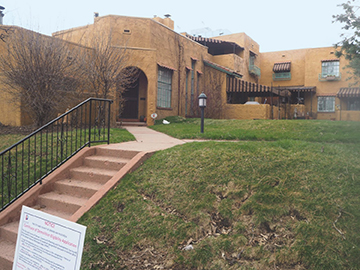
by Luke Schmaltz
On the corner of Emerson and the 900 block of E. 1st Ave. in Denver’s Speer neighborhood sits Carmen Court — a 95-year-old piece of Denver history that is figuratively torn apart, a notion that could soon take place in the literal sense.
The forces at work here are three-fold, involving the will of the owner occupants, the wishes of the surrounding neighborhood and the financial leverage of an international real-estate development company.
From The Inside Out
The owners of the six condominium units at Carmen Court — a Pueblo Revival Style multi-family complex built in 1925 are looking at a financial windfall. According to an article by BusinessDen.com, the entire property has a list value of $5.5 million, indicating that the owners of each unit could anticipate an average payout of $916,000.

The owner-occupants of Carmen Court recently aligned with the property owners of the three residential lots to the south in order to broker a deal to sell the dirt beneath the buildings to Hines, a Texas-based real estate investment, development and management firm that plans to erect a five+ story assisted living facility. One of the terms of this deal is that the owners will arrange to have the properties demolished before Hines will close on the contract. Upon applying for a permit to do so and then posting said permit as required by law, there was significant outcry among the area residents. This prompted neighbors to seek a preservation-minded approach by filing for Carmen Court to bear a landmark designation status.
The numerous “No Trespassing” signs made it apparent that knocking on doors for an interview was ill advised. Yet, numerous stories from other news sources confirm that Carmen Court residents are not interested in the preservation approach, citing a unanimous desire to sell rather than incurring the increasingly costly expense of upkeep on a century-old building.
From The Outside In
Neighbors, members of the West Washington Park Neighborhood Association, and an amalgam of Denver-based architects and preservationists, have come together to form Friends of Carmen Court (FoCC). Contrary to what the name suggests, members of FoCC do not share the same vision as the current owner occupants. From the FoCC’s perspective, however, the proposed nine-lot development plan represents a potential monstrosity that will further erase the heritage and identity of their community.

While the residents of Carmen Court are obviously interested in selling and moving on, the FoCC have other motivations. Mark Harris, a group member and one of the three neighbors required for the filing of the landmark designation states via email: “We, the three near neighbors, have been in discussions with the owners and Hines on how the building can have an adaptive re-use within the new development. We are also trying to find another buyer to step in and develop the site while preserving the building. We are not trying to prevent density or new development in our neighborhood; we’re just trying to save an important building from ending up in the landfill. While some have painted the picture as an either-or, we see it as both-and. Hines can buy the building from the owners at their asking price, and still save the building by incorporating it into their new development. We have just all agreed on a 45-day extension to allow for time to reach an agreement before the issue is in front of City Council on Nov 2nd.”
Meanwhile, FoCC member Sarah McCarthy voices a community-wide aesthetic concern about the idea of losing Carmen Court, stating: “It’s really part of the neighborhood. It is truly unique in its landscaping and design. The owners may not be interested in (historical) designation, but we see the building as having a larger architectural and historical significance.”
From The Top Looking Down
The proposed compromise would require Hines to preserve the exterior integrity of Carmen Court, and perhaps repurpose the condos for reception areas, dining facilities or street-level storage while somehow erecting a multi-story assisted living facility around the existing structure. While this sort of a compromise sounds a bit farfetched, it is not unheard of in other redeveloping parts of Denver. Recently, similar historical landmark designations have been passed for places like Tom’s Diner on Colfax and the Howard Berkeley Park Chapel of Tennyson St. While both involved some level of compromise, neither included building a high-rise residential behemoth atop a century-old structure.

Hines Managing Director Chris Crawford, while unavailable for comment, was recently quoted on the matter at Business Den.com. He indicated that Hines would consider walking away if another developer would agree to taking over the existing contract with the Carmen Court owners. This new developer, in the event of a historical designation being assigned to the property, would have to build around the existing structure while assuring that Hines be reimbursed for their out-of-pocket expenses incurred thus far.
While a land swap with another developer was discussed, the deal was turned down by Hines due to the location of the other property. At any rate, whether an historical designation is assigned to the property is up to what the Denver City Council decides when the 45-day extension is up in mid-October. If so, the next step is up to the willingness of the Development Industrial Complex to settle for a compromise. If there is no historical designation, you can bet there will soon likely be no Carmen Court.
At any rate, the fate of Carmen Court is yet unknown, but currently it appears to be in the hands of those who have the least to lose.
